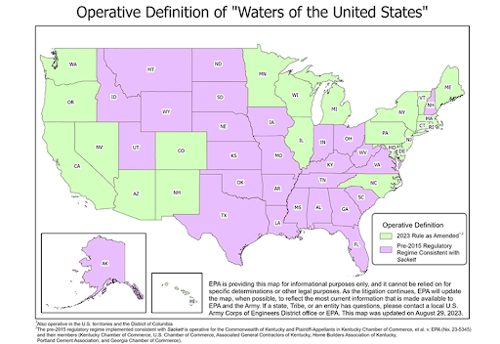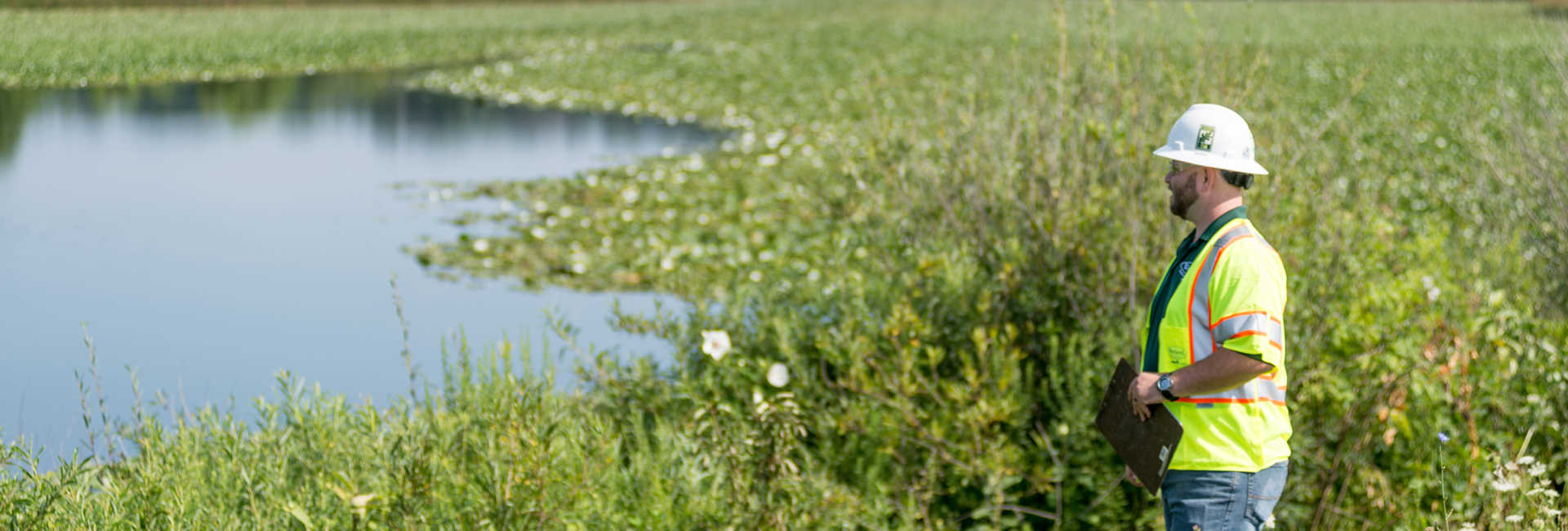On August 29, 2023, the U.S. Environmental Protection Agency (EPA) and U.S. Army Corps of Engineers (USACE) announced a final rule amending the 2023 definition of “waters of the United States” (WOTUS). These changes to the January 2023 Rule are intended to conform with the May 25, 2023 decision of the U.S. Supreme Court in the case of Sackett v. Environmental Protection Agency. The decision in Sackett made clear that certain aspects of the 2023 rule are invalid. According to EPA’s recent announcement, the amendments to the rule provide clarity for regulating wetlands consistent with the Supreme Court’s decision. The amended final rule became effective upon publication in the Federal Register on September 8, 2023.
What Does the New Rule Do?
Most significantly, the new rule does the following:
- It removes the Significant Nexus Test. This test, a result of the Rapanos¹ Supreme Court Case, allowed the EPA and USACE to evaluate waters (tributaries, ponds etc.) and wetlands, either separately or collectively, by whether they had a “material influence on the chemical, physical or biological integrity of waters of the United States”. Without such a test, these wetlands are no longer regulated under the Clean Water Act (CWA) unless they are Adjacent Wetlands.
- It revises the Adjacent Wetlands definition. Wetlands adjacent to the territorial seas, interstate waters, waters able to carry interstate commerce and their tributaries are regulated under the CWA. For most of the period from 1986 to 2023 the definition of adjacent wetlands remained unchanged. Over this period, a wetland that was “bordering, contiguous or neighboring” one of these other waterbodies was “adjacent” and thus regulated under the CWA. The Supreme Court looked back to the original CWA legislation and deliberations over the legislation and decided that this definition was overly broad and that instead only wetlands “having a continuous surface connection” should be regulated as adjacent.
A redline of the rule’s definition can be viewed here.
What Are the Consequences of These Changes?
The consequences of these changes can be significant:
- Tributaries can no longer simply have a significant nexus to the traditional waters regulated by the CWA. The Supreme Court in Sackett unanimously agreed with the plurality of the Supreme Court in Rapanos that tributaries had to be “relatively permanent, standing or continuously flowing bodies of water.” The plurality in that earlier case explained that “relatively permanent” waters did “not necessarily exclude streams, rivers or lakes that might dry up in extraordinary circumstances, such as drought” or “seasonal rivers which contain continuous flows during some months of the year but no flow during dry months.” Consequently, it appears the EPA and USACE will no longer regulate “ephemeral water bodies” that flow or contain water only immediately after rain events and are not receiving groundwater input for at least a season or longer. Examples include some shallow natural ravines, many road-side ditches and shallow depressions.
- Adjacent wetlands (per the Sackett decision) must now have a “continuous surface connection to bodies that are waters of the United States in their own right, so that there is no clear demarcation between waters and wetlands.” Wetlands now separated from traditionally regulated waters by berms or other obstructions will no longer be regulated. Such wetlands can be thought of as “isolated” as they are no longer regulated by the USACE. So, this revised rule expands the number of isolated wetlands not regulated by the USACE under the CWA.
- Wetlands can no longer be regulated simply because they are interstate in nature (cross a state line) and must now meet the adjacency test. Otherwise, they will not be regulated by the Corps under the CWA.
No Changes to the Exclusions from “Waters of the United States”
The amendments to the January 2023 Rule do not change the existing exclusions from the definition of “waters of the United States” These exclusions are:
- Prior converted cropland, adopting USDA’s definition and generally excluding wetlands that were converted to cropland prior to December 23, 1985.
- Waste treatment systems, including treatment ponds or lagoons that are designed to meet the requirements of the Clean Water Act.
- Ditches (including roadside ditches), excavated wholly in and draining only dry land, and that do not carry a relatively permanent flow of water.
- Artificially irrigated areas that would revert to dry land if the irrigation ceased.
- Artificial lakes or ponds, created by excavating or diking dry land that are used exclusively for such purposes as stock watering, irrigation, settling basins, or rice growing.
- Artificial reflecting pools or swimming pools, and other small ornamental bodies of water created by excavating or diking dry land.
- Water-filled depressions, created in dry land incidental to construction activity and pits excavated in dry land for the purpose of obtaining fill, sand, or gravel unless and until the construction operation is abandoned and the resulting body of water meets the definition of “waters of the United States.”
- Swales and erosional features (e.g., gullies, small washes), that are characterized by low volume, infrequent, or short duration flow.
Additionally, the agencies’ amended definition of “waters of the United States” does not affect the longstanding activity-based agricultural and silvicultural exemptions of the Clean Water Act.
When Will These Revisions Be Applicable to Wetland Delineations and Permits?
While the rule became effective as of its publication in the Federal Register on September 8, it is not currently being applied in the field. It remains to be seen exactly how the rule will be implemented by the USACE. USACE Headquarters is expected to provide formal guidance on how to apply the new rule, though it remains uncertain as to when Headquarters will issue the guidance.
Does This Apply Everywhere in the United States?
Note that due to recent District Court rulings, there are orders preliminarily enjoining the January 2023 WOTUS Rule in 27 states. As a result, these 27 states are not regulated by the January 2023 Rule. Instead, the EPA and USACE are applying a “pre-2015 regulatory regime” within these 27 states until such time the legal challenges to the 2023 WOTUS Rule are resolved.
Based upon the on-going legal challenges in the 27 states, there is essentially a bifurcated regulatory program in which the following regulatory standards are being applied:
- The EPA and USACE will implement the definition of “waters of the United States” under the January 2023 Rule, as amended by the conforming rule published September 8, in 23 states (refer to map below).
- In the other 27 states, the agencies are interpreting “waters of the United States” consistent with the pre-2015 regulatory regime and the Sackett decision until further notice. The pre-2015 regulatory regime did not include the term “significant nexus” and will have its definition of adjacent wetlands and other appropriate terms revised consistent with the Sackett decision and current regulations.
Refer to the map below and the following EPA Operative Definition of WOTUS: Definition of "Waters of the United States": Rule Status and Litigation Update | US EPA

For More Information
Please contact your local Davey Resource Group office to see how the new federal rule applies to your property or project. Additional information is also available on EPA’s Waters of the United States website.



